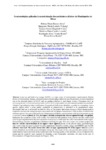Please use this identifier to cite or link to this item:
http://www.alice.cnptia.embrapa.br/alice/handle/doc/1041244| Title: | Geotecnologias aplicadas à caracterização dos ambientes cafeeiros da Mantiqueira de Minas. |
| Authors: | ALVES, H. M. R.  VALPATO, M. M. L.   VIEIRA, T. G. C.   LACERDA, M. P. C.   BORÉM, R. A. T.   BORÉM, F. M.   |
| Affiliation: | HELENA MARIA RAMOS ALVES, SAPC MARGARETE MARIN LORDELO VOLPATO, EPAMIG TATIANA GROSSI CHQUILOFF VIEIRA, EPAMIG MARILUSA PINTO COELHO LACERDA, UNB ROSÂNGELA ALVES TRISTÃO BORÉM, UFLA FLÁVIO MEIRA BORÉM, UFLA. |
| Date Issued: | 2015 |
| Citation: | In: SIMPÓSIO BRASILEIRO DE SENSORIAMENTO REMOTO, 17., 2015, João Pessoa. Anais... São José dos Campos: INPE, 2015. p. 3635-3639 , 2015 |
| Description: | Land-use and land-cover change (LUCC) is a major cause of environmental transformation. Distant drivers of local land use changes, often associated with emerging markets for specific products, are now considered one of the principal factors of LUCC and are gaining attention in land change science. Consumers show an increasing interest in local and quality food certified for its origin and/or its environmental production standards. A kind of agricultural product certification, Geographical Indications identifies a product as originating from a specific region where a given quality, reputation or characteristic is attributed to its geographical origin. Sustainable land use is potentially an indirect effect of Geographic Indications because a better management is required to preserve the natural resources associated with the unique characteristics of the product. Located in the southern region of the state of Minas Gerais is Mantiqueira de Minas, considered one of the most important regions of specialty coffees in Brazil. In 2011, the region?s tradition and reputation were recognized through a Geographic Indication, the second for coffee in the country. To exploit the full potential of this area for specialty coffees and meet the growing demand for this new segment it is necessary to understand the coffee environments in the region. Geotechnology can have a significant contribution in filling this gap. This work is part of a research project that aims at a detailed characterization of the region?s coffee agroecosystems. In the present study, geotechnologies were used to map the areas occupied by coffee plantations. RapidEye satellite images and SPRING and ArcGIS softwares were used. The results showed that coffee occupies approximately 8% of the region?s total area and is mostly distributed in the hilly areas with higher elevations. The results of this study provide information to better understand the factors involved in the expression of the beverage quality of the specialty coffees produced in the region and the scientific basis required for obtaining a new Geographic Indication, this time in the type of Denomination of Origin (Denominação de Origem - DO). |
| Thesagro: | Café |
| Type of Material: | Artigo em anais e proceedings |
| Access: | openAccess |
| Appears in Collections: | Artigo em anais de congresso (SAPC)  |
Files in This Item:
| File | Description | Size | Format | |
|---|---|---|---|---|
| Geotecnologiasaplicadas.pdf | 406.76 kB | Adobe PDF |  View/Open |









